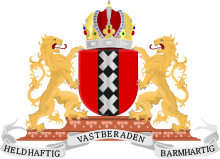
A coat of arms is a heraldic visual design on an escutcheon, surcoat, or tabard. The coat of arms on an escutcheon forms the central element of the full heraldic achievement, which in its whole consists of a shield, supporters, a crest, and a motto. A coat of arms is traditionally unique to the armiger. The term 'coat of arms' itself, describing in modern times just the heraldic design, originates from the description of the entire medieval chainmail 'surcoat' garment used in combat or preparation for the latter.

In heraldry, cadency is any systematic way to distinguish arms displayed by descendants of the holder of a coat of arms when those family members have not been granted arms in their own right. Cadency is necessary in heraldic systems in which a given design may be owned by only one person at any time, generally the head of the senior line of a particular family.
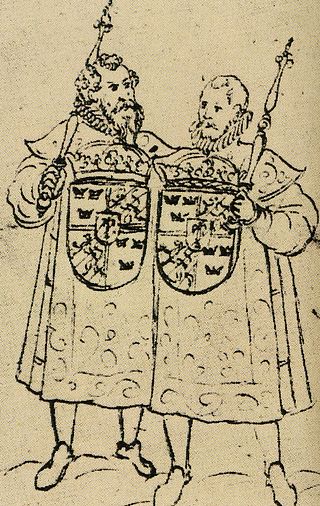
Swedish heraldry encompasses heraldic achievements in modern and historic Sweden. Swedish heraldic style is consistent with the German-Nordic heraldic tradition, noted for its multiple helmets and crests which are treated as inseparable from the shield, its repetition of colours and charges between the shield and the crest, and its scant use of heraldic furs. Because the medieval history of the Nordic countries was so closely related, their heraldic individuality developed rather late. Swedish and Finnish heraldry have a shared history prior to the Diet of Porvoo in 1809; these, together with Danish heraldry, were heavily influenced by German heraldry. Unlike the highly stylized and macaronic language of English blazon, Swedish heraldry is described in plain language, using only Swedish terminology.
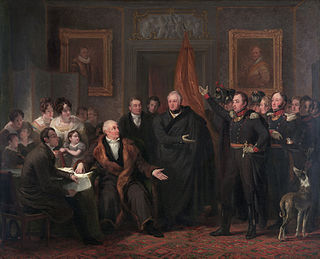
The Dutch nobility is a small elite social class constisting of individuals or families recognized as noble, and with or without a title of nobility in the Kingdom of the Netherlands.

Norwegian heraldry has roots in early medieval times, soon after the use of coats of arms first appeared in continental Europe. Some of the medieval coats of arms are rather simple of design, while others have more naturalistic charges. The king-granted coats of arms of later times were usually detailed and complex. Especially in the late 17th century and the 18th century, many ennobled persons and families received coats of arms with shields containing both two and four fields, and some even with an inescutcheon above these.

The Flemish Heraldic Council advises the Flemish Government on all matters relating to heraldry. The Council was created on 11 April 1984, as the successor to the Subcommittee for Heraldry or Subcommissie Heraldiek, established in 1978. Its prime task was to supervise the granting of a coat of arms and a flag to all municipalities of the Flemish Region. Following the reorganization of the Belgian provinces, the council's field of action was extended to provincial arms and flags in 1994. Since 2000, the Council has likewise advised the Flemish Government on grants of arms to Flemish individuals and corporations. In the meantime, more than 200 such grants have received official sanction. Grants of arms by the Flemish Government are published in the Belgian official journal.

Johannes Baptista Rietstap was a Dutch heraldist and genealogist. He is most well known for his publication of the Armorial Général. This monumental work contains the blazons of the coats of arms of more than 130,000 European families. It is still one of the most complete works of its kind.

The coat of arms of Amsterdam is the official coat of arms symbol of the city of Amsterdam. It consists of a red shield and a black pale with three silver Saint Andrew's Crosses, the Imperial Crown of Austria, two golden lions, and the motto of Amsterdam. Several heraldic elements have their basis in the history of Amsterdam. The crosses and the crown can be found as decorations on different locations in the city.

The current Crown of the Netherlands is of relatively modern origin. In 1813 the new "Sovereign Ruler" of the Netherlands, Prince Willem of Orange, son and heir of the exiled stadtholder Willem V of Orange, was sworn in as Dutch monarch in Amsterdam. There was no crown present at the ceremony.
A heraldic authority is defined as an office or institution which has been established by a reigning monarch or a government to deal with heraldry in the country concerned. It does not include private societies or enterprises which design and/or register coats of arms. Over the centuries, many countries have established heraldic authorities, and several still flourish today.
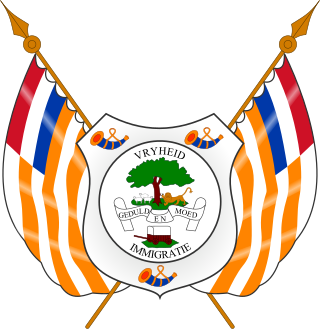
The coat of arms of the Orange Free State was the official heraldic symbol of the Orange Free State as a republic from 1857 to 1902, and later, from 1937 to 1994, as a province of South Africa. It is now obsolete.

The coat of arms of Sint Eustatius consists of a shield and the motto. It was established on 9 November 2004 by the Island council of Sint Eustatius, when it was still part of the Netherlands Antilles. It remained the coat of arms of Sint Eustatius after the dissolution of the Netherlands Antilles and the subsequent change of Sint Eustatius's constitutional status into a special municipality of the Netherlands in 2010.
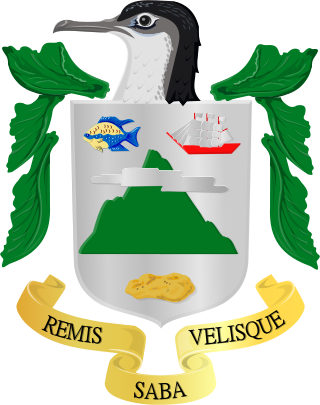
The coat of arms of Saba was established in 1985 by the island council of Saba, when it was still part of the Netherlands Antilles. It remained the coat of arms of Saba after the dissolution of the Netherlands Antilles, and the subsequent change of Saba's constitutional status into a special municipality of the Netherlands in 2010.

The coat of arms of Bonaire was established in 1986 by the island council, when Bonaire was still part of the Netherlands Antilles. It remained the coat of arms of Bonaire after the dissolution of the Netherlands Antilles and the subsequent change of Bonaire's constitutional status into a special municipality of the Netherlands in 2010.

The coat of arms of Hoorn is a coat of arms that has been in use since the middle ages. Although over time it underwent some changes, there has been no change to the coat of arms since it was acknowledged in use by the High Council of Nobility in 1816. At present, in the original form, it is the coat of arms of the municipality of Hoorn. The current municipality was formed in 1979 by merging the city of Hoorn with the villages Zwaag and Westerblokker; it was decided to use the old coat of arms as coat of arms of the new municipality.

The coat of arms of Zaanstad has been formally acknowledged since 27 February 1974. The coat of arms was previously that of the jurisdictional area of Westsane en Crommenie, which now form the municipality of Zaanstad. These two areas were on the same areas as the municipalities who fused in 1974 to become the municipality of Zaanstad. The municipality of Assendelft alone used a coat of arms who didn't look like those of the other municipalities. The other municipalities and places used a coat of arms with four lions in it.

The flag of Scheveningen is in azure with three right swimming herrings of silver, each herring with a three-leaved yellow crown, floating above the head. The origin of the coat of arms is a matter of debate because Scheveningen is not, and never has been, an autonomous municipality. Since the village was founded in 1284, Scheveningen has always been a part of the municipality of The Hague.

The coat of arms of Groningen is an official symbol of the province. It was designed when the region was united in 1595 and formally approved in 1947 by Queen Wilhelmina. The coat of arms consists of two lions supporting a crowned shield which is decorated with the shields of the city of Groningen and of the Ommelanden.

The coat of arms of Enkhuizen has been the coat of arms ever since Enkhuizen received borough rights in 1355. The coat of arms was acknowledged in 1816 by the High Council of Nobility, the coat of arms has not been changed ever since.

Belgian heraldry is the form of coats of arms and other heraldic bearings and insignia used in the Kingdom of Belgium and the Belgian colonial empire but also in the historical territories that make up modern-day Belgium. Today, coats of arms in Belgium are regulated and granted by different bodies depending on the nature, status, and location of the armiger.



































